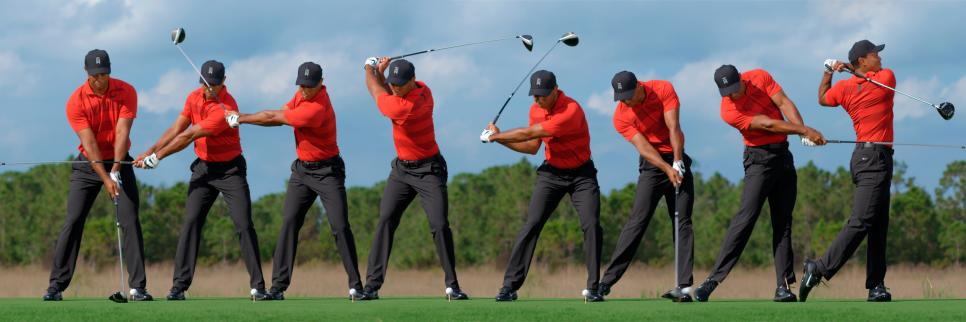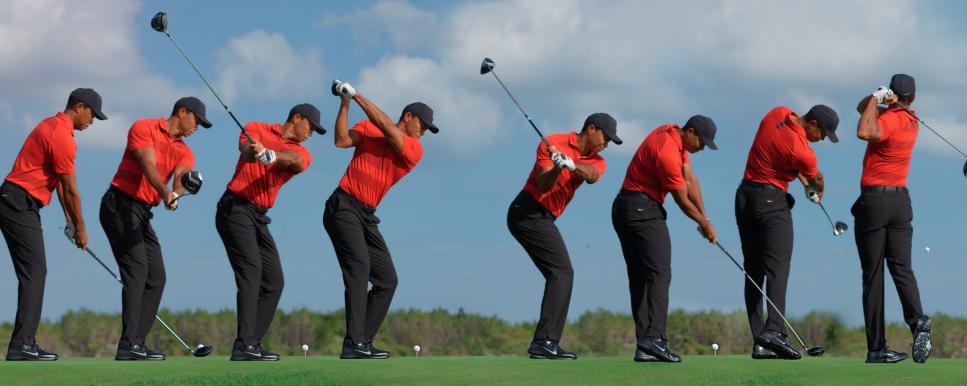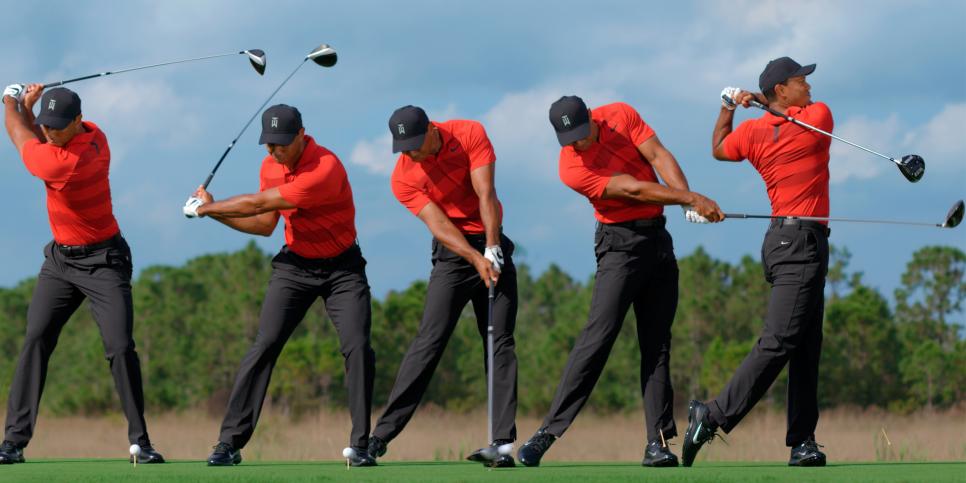Editor's note: This article was originally published in 2018.
At the conclusion of this year's Wells Fargo Championship, having competed in seven PGA Tour events, Tiger Woods ranked 206th on tour in fairway accuracy (51 percent). Early-season performances like at the Farmers Insurance Open, where he hit only 17 fairways in four rounds, contributed a lot to his ranking and aren't indicative of what he should expect going forward, says Golf Digest 50 Best Teacher David Leadbetter.
"That's why these photos taken early in the season are very interesting," Leadbetter says. "There's a lot to like here, but it was probably to be expected that it would take Tiger a few tournaments until he could trust this swing and feel comfortable with his new process. The more tournaments Tiger has played, the more comfortable he has started to look, hitting more fairways. Even the wild ones have plenty of power. And if you want to know why I think his driving numbers will improve, there is one thing in particular that stands out as the key to his future success."
Before Leadbetter reveals what that one thing is, he offers a history lesson. Ben Hogan was a great player before and after a near-fatal car accident in 1949. But it's not hard to determine on which side of his career he enjoyed more success. Hogan won six of his nine major championships after the car crash.
"Prior to the accident, Hogan had a fairly long swing with very aggressive lower-body motion and hip rotation," Leadbetter says. "After the accident, his injuries prompted him to instinctively calm down his leg action and shorten his swing, which made it more efficient, repetitive and gave him supreme control over his shotmaking."
Similarly, Woods has had to adjust his swing to cope with a multitude of injuries and, most recently, surgery that fused vertebrae in his lower back. If he can stick with the changes seen here, his driving will be much more reliable, Leadbetter says.
"The biggest thing to note is his transition from backswing to downswing. It's much quieter than it used to be. He has eliminated the violent move into the ball. There's not a big sinking of the knees and then a stand-up look coming into impact. He's maintaining his height much better, and that gives him room to powerfully release the club. Woods' swing looks a lot more in sync with great rhythm."
And by rhythm, Leadbetter says he doesn't mean Woods is swinging his driver slower than he did before the surgery. In fact, his driver clubhead speed is one of the fastest on tour (121 miles per hour on average). Rhythm means the flow in which he transitions from backswing to downswing.

“HE’S MOVING BETTER THAN I’VE SEEN IN QUITE A WHILE. HIS SWING LOOKS MORE GRACEFUL.” —DAVID LEADBETTER
The key move, the one amateurs should strive to copy, Leadbetter says, is letting speed build as it approaches the ball and swinging the club fastest through impact. By quieting excessive lower-body motion, Woods has more stability in his swing, giving him greater balance. Woods appears to start down slower than in the past but then really whips the club through the hitting area. If you look at this view of his driver swing above, take note how loaded he is as he completes the backswing. He then makes a simple move back to his left side and the arms drop, so he can deliver the full force of his arms and hands into the ball without getting stuck, Leadbetter says.
"Stuck is the feeling Tiger complained of frequently when he would get his arms trapped behind his body," he says. "Here, Tiger has plenty of room for his arms to accelerate into the ball. See how his right arm is really giving the ball a whack and is crossing over the left in the follow-through. His arms and club are fully extended, and he finishes in a relaxed position. There's no stress on the body."
In the past, Woods' finish often had a "manufactured" or off-balance look, Leadbetter says, as a result of trying to square the club with an out-of-sync swing.
Another facet of Woods' swing to copy is the way he takes the club back, Leadbetter says. Woods keeps the club in front of his torso, and the clubhead stays outside the path of his hands and close to the target line.
"It's a great one-piece motion—the chest, arms and club are all moving back together with plenty of width," he says.
This move encourages the body to coil, not just turn, with the shoulders rotating on a slightly tilted axis. If you make a flat turn, the tendency is to drag the club inside the target line and then re-route it on a steep, out-to-in path into the ball. Slices and pulls are the typical result, he says.
"His backswing has looked similar to this over the years, but I see a subtle and vital difference now," Leadbetter adds. "It appears to be more synchronized. The turning of his body and his arm swing finish almost in unison at the top. His body used to complete the turn, and then his arms would run on independently trying to catch up on the downswing."
Whether or not it's a side effect of his back issues, his calmer, better synchronized backswing has a more efficient look, Leadbetter says. And the fact that Woods can swing in excess of 120 mph, but his clubshaft isn't parallel to the ground at the top, proves that you don't need a long, unwieldy backswing to generate real power. Leadbetter circles back to the concept of good rhythm as the hallmark of great driving. Don't be in such a rush to get the club back down to the ball, he says.
"I really liked what I saw of Tiger's swing on the practice tee at the Masters, and what he's been able to do overall since having that back-fusion surgery," Leadbetter says, pausing for a moment before finishing with a joke. "But this is not to suggest everyone should go out and have their back fused."

Photo by Dom Furore
WOODS’ DRIVER SWING SPEED IS 8 MILES PER HOUR FASTER THAN THE PGA TOUR AVERAGE OF 113 MPH.
PRO-FILE: TIGER WOODS
AGE: 42 / 6-1 / 185 pounds Jupiter, Fla.
DRIVER: TaylorMade M3 460 (8.5 degrees)
BALL: Bridgestone Tour BXS
